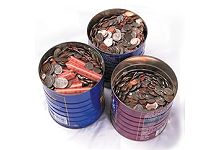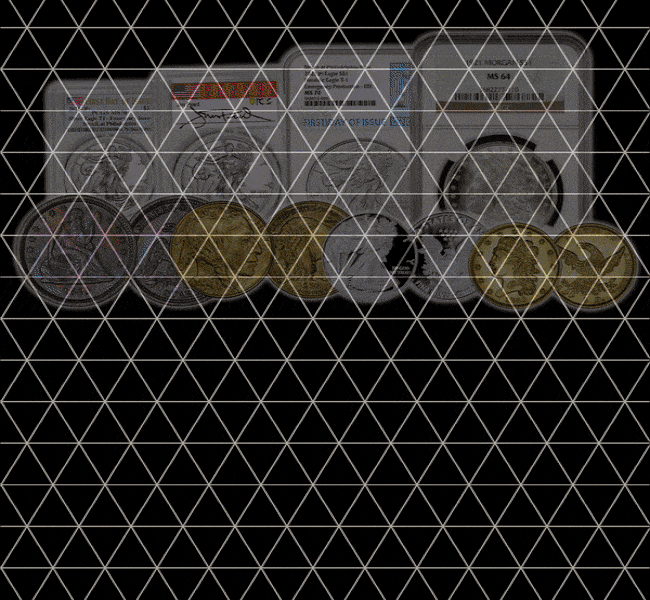By Peter Mosiondz, Jr. on Collecting Strategies ….
The wonderful thing about coin collecting is that you do not have to be wealthy to enjoy the many pleasures that our hobby provides. There are numerous methods of acquiring coins, many of which are quite inexpensive.
One fun way to begin a collection is to search your everyday pocket change. By doing this over a period of time you will have many different dates in every circulating denomination. You will eventually discover that you have several duplicates. Compare the pieces and keep the one that is superior in condition, the one that possesses greater eye appeal. This method of improving one’s collection is called “upgrading”.
Every collector aspires to have the best possible coin in his or her collection. Upgrading from routine pocket change is one way to do this without great cost.
Mother, father, sister, brother, husband, wife and other relatives and friends can easily be persuaded to save any old or unusual coins for you.
 When I was beginning my coin collection about 50 years ago, my mother was a waitress and my dad was a church collector on Sundays. Every evening when my mom came home from work, she would allow me to go through her tip money for coins that I might need. Then the next day she would return the unneeded coins to the delicatessen where she worked. I was able to form complete sets of many series, including the U.S. Washington quarters which included the two key dates, 1932-D and 1932-S. I would also keep many of the duplicate key and semi-key coins that I found in change for trading purposes.
When I was beginning my coin collection about 50 years ago, my mother was a waitress and my dad was a church collector on Sundays. Every evening when my mom came home from work, she would allow me to go through her tip money for coins that I might need. Then the next day she would return the unneeded coins to the delicatessen where she worked. I was able to form complete sets of many series, including the U.S. Washington quarters which included the two key dates, 1932-D and 1932-S. I would also keep many of the duplicate key and semi-key coins that I found in change for trading purposes.
A “key” coin is considered to be a very scarce and valuable coin in a particular series. These are usually the most expensive coins in a particular series. A “semi-key” coin is another low mintage coin that is considered difficult to find in ordinary change and has some modest value attached to it.
When my dad was counting that day’s donations from the collection baskets, he would set aside any older coins for me and replace them with his own money. He had a great feel for what I was looking for. He did the same thing for me in his other part-time job as a weekend bartender in a local club. Needless to say I was most fortunate in these regards and was able to complete my sets in short order.
Once I got a bit older and my dad knew that coin collecting was not just a passing fancy but a lifetime pursuit, he took me to his bank and introduced me to a couple of friendly tellers that he knew. He suggested that I be allowed to purchase rolls of coins of the various denominations. He also funded me in getting started. He also told me that any coins I would keep for my collection would be deducted from my weekly allowance or I could choose to replace the coins I needed from my own change. I didn’t argue for it was a very fair accommodation.
The bank had several tables and chairs in their lobby for the use of patrons when filling out their various banking forms; unlike today where most banks do not provide these creature comforts. The tellers encouraged me to do my roll searching at one of these tables. My dad was very patient in this regard and allowed me several trips each day to the counter to return the rolls I had searched through for some different rolls of coins. We did this once a week, usually on a Saturday morning. The number of coins needed to complete a series was dwindling. I even completed some duplicate sets, especially the Jefferson nickels which were easy to assemble back then, even the key 1950-D.
Coin collecting is contagious though. My enthusiasm affected a couple of close friends and they took up the hobby as well. Trading coins amongst ourselves was yet another neat way of getting those needed coins.
Soon we formed a coin club. We spoke about this in a previous segment.
Several years passed and I was getting ready to enter high school. In the six years that I had been collecting, only two regular series coins eluded me – the 1909-S VDB Lincoln cent and the 1916-D Winged Head (or Mercury) dime. I am not including the silver dollars. They were readily available for a dollar at the banks but my allowance and part-time job, once I entered high school, would not permit an extensive number of dates and mint marks. I was able to find many scarce semi-key examples though and these I kept.
Once in a while I found coins in bank rolls that were not normally encountered in circulation. These included Indian Head cents, Liberty nickels and the Barber dimes, quarters and half dollars. I wanted to form a collection of some of these but how to go about doing it? The answer was easy enough; visit a coin dealer.
As I recall, back in the 1950s, there were dozens of coin shops in Philadelphia where I grew up. About a dozen or so were within easy walking distance in the downtown area. There were two blocks that had coin stores next door to each other. It was surely a Mecca for us coin enthusiasts. Most dealers seemed to enjoy taking care of us kids. The reasoning is simple enough. A kid today with a very modest budget will eventually become an adult with more disposable income. As I grew older and married I visited most of these same dealers. They all had Saturday hours as well and every store would be filled with collectors, young and old alike.
Today of course things are quite a bit different. A collector is lucky to find one or two coin shops within an easy commute from home. The mom-and-pop coin stores of my day can no longer exist in metropolitan shopping districts due to the vastly increased property costs and rents. My suggestion is that if you are fortunate enough to have a local coin store, do everything you can to patronize it. I have always enjoyed the face-to-face dealings that a coin store provides.
Many coin stores have so-called “junk” boxes in which one can obtain various coins, some older and worn and some recent, at nominal prices. Even now I still have a great deal of fun hunting for coins in this fashion.
For those not near a coin store, nothing beats the comfort and convenience of buying coins through a mail order dealer. Every issue of Coin World and Numismatic News features scores of advertisements from the leading mail order dealers. A wide array of offerings is available for your consideration. You are able to examine your purchases in the comfort of your own residence and avail yourself of the dealer’s return privilege to send back any coin that does not meet up to your expectations. If it were not for the advertising revenue from these fine dealers, chances are that the publication’s subscription price would be prohibitive.
Then we have the internet with its vast directory of things numismatic and places to buy and sell.
Coin conventions are another neat way to buy coins. Attending a convention or show is like visiting dozens, if not hundreds, of coin shops under one roof. Try to visit one in your area and experience a new world of coin buying.
Later on in my collecting life I discovered auctions and mail bid sales. These are another fascinating way to get coins, and at your price. Later in this series we’ll cover some of these “other ways” to acquire those needed coins.
So, you see, there are many different ways to build up your coin collection – a collection that began with a very modest cost.
